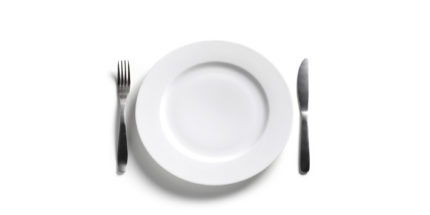What if you discovered that the best place to begin your personal pursuit of happiness is at the end of your fork? Well, prepare to polish your silverware. Emerging research from the fields of neuroscience and nutrition shows that by changing what you eat, you can stabilize your mood, improve your focus, and boost yourbrain health, all while trimming your tummy.
We call this way of eating the Happiness Diet. And fear not: It’s not all carrot sticks and raw broccoli. It includes foods that are rich in nutrients like vitamins A, B12, D, and E, and folate, iodine, magnesium, calcium, iron, fiber, and omega-3 fatty acids—your Essential Elements of Happiness.
Food is directly linked to three areas of brain function that create your “happiness ability.” The first is your capacity to focus, think, plan, and remember (we call them “foods for thought”). The second is emotional regulation (“foods for good mood”). And third are foods that give you the ability to power through a deadline and control anxiety (“foods for energy”).
Happiness Rules
If you want to tap into the mental well-being that comes from the Happiness Diet, follow these basic guidelines.
RULE 1: Reduce the amount of processed food you eat.
Much of it is loaded with sugar, and too much of the sweet stuff actually contributes to the shrinkage of key brain areas involved in mood regulation.
RULE 2: Eat more fruits, vegetables, and whole grains.
Plant foods contain the minerals, vitamins, and phytonutrients that we call the Essential Elements of Happiness–substances your brain needs for optimal functioning.
RULE 3: Opt for grass-fed meat, whenever possible.
Compared with typical grain-fed meat, grass-fed has more omega-3 fatty acids, an Essential Element of Happiness that promotes formation of new brain connections.
RULE 4: Strive for variety.
The greater the range of whole foods you consume, the broader the range of brain-boosting nutrients your diet will certainly contain—and the sharper, merrier, and more energized your mind will be.
Foods for Thought
Eggs. What if we could create the perfect brain food? For starters, we’d want some vitamin B12, which is crucial for nerve cells. A deficiency causes irritability, depression, and cognitive decline.
Next we’d add a little folate to keep our brain’s neurotransmitter factories humming. Iodine would be another plus, since it is essential for good thyroid function—and an underactive thyroid leads to lethargy, weight gain, and depression. Finally, studies have increasingly linked low levels of vitamin D to depression, dementia, Parkinson’s disease, and PMS, so we’d love to include some of this nutrient, which is hard to find in nonfortified foods. This is just a partial profile of a standard barnyard egg—a nutritional powerhouse.
Grass-Fed Butter. No more confusion about what to smear on your toast: Butter is brain food. It has a long list of nutrients that are not found in most vegetable oils—including vitamin A (which promotes the production of neurotransmitters such as dopamine that are key players in mood and memory), along with vitamins D and B12.
Butter from grass-fed cows is even healthier. It contains omega-3 fatty acids, which cool inflammation and promote the growth of new brain connections. It also delivers higher levels of a special fat called conjugated linoleic acid, or CLA, which increases blood flow to the brain, extends the life of brain cells, and counteracts the effects of the stress hormone cortisol. In short, the more fresh grass a cow eats, the more nutritious its milk and butter.
Foods That Boost Brainpower
Grass-Fed Beef. Yes, red meat is brain food. It contains heme iron, which is the most absorbable form. The brain needs a constant flow of oxygen, and that depends on eating enough iron for red blood cells. Red meat is also a top source of vitamin B12, and it’s one of the best sources of zinc, which research suggests improves academic performance. And if you stick with grass fed, you’ll also get 300 to 500% more CLA than with conventional beef!
Anchovies. The densest source of omega-3 fatty acids is cold-water fatty fish, and anchovies have twice as much as tuna. Pregnant women who eat more omega-3s have children with higher IQs. Anchovies are healthier than tuna for another reason too: They’re low on the food chain, so they’re often virtually free of brain-damaging mercury.
Foods for Energy
Arugula. Dark, leafy vegetables are among the most nutrient-dense foods we eat. In fact, folate, which protects us from depression, originates in the leaves of plants. (Its name comes from the Latin word folium, for “leaf.”) But arugula offers far more. As a kid, you were probably told a thousand times what a great source of calcium milk is, but you probably weren’t told that greens also contain calcium. It triggers the release of neurotransmitters every time a neuron fires. Two cups of arugula have just 10 calories but contain 6% of your daily need for calcium, plus two other Essential Elements of Happiness, folate and fiber. The latter is important for maintaining a healthy gut, which is crucial for the proper absorption of other nutrients. Diets low in fiber have been linked to depression and increased risk of suicide. And arugula’s deep green color indicates the presence of yet another of our top happiness nutrients, magnesium.
Coffee. Caffeine causes an increase in dopamine, which is how it boosts your confidence, focus, and mood. In addition to its stimulating properties, a cup of coffee has more antioxidants than a glass of grape juice or a serving of spinach. And it contains two phytonutrients, norharman and harman, which function like a class of antidepressants called monoamine oxidase inhibitors. People who drink a few cups of coffee daily have a decreased risk of brain disorders such as depression and dementia.
Walnuts. You can fit one walnut in the palm of your hand–yet it has all the building blocks to grow into a tree that’s nearly as wide as a school bus and as tall as a 10-story building. Nuts contain a wealth of trace minerals, macronutrients, and vitamins, including magnesium, copper, iron, manganese, zinc, calcium, omega-3s, vitamin E, and folate and other B vitamins–they’re sort of like multivitamins, except designed by nature. The various forms of vitamin E work to relieve brain inflammation and protect neurons. Patients with major depression often have low levels of vitamin E in their blood.
Blue-or Red-Skinned Small Potatoes. Because we confuse the pure food with the processed version, potatoes have a bad rep. A potato skin has just as many phytonutrients as broccoli—especially if you eat the more colorful varieties. Unusual nutrients found in potatoes, known as kukoamines, can lower blood pressure, which protects the brain. But potatoes are also loaded with Essential Elements of Happiness such as folate and iodine. As noted above, iodine is critical for the proper functioning of the thyroid gland, which in turn is a mood regulator. One of the first things a psychiatrist checks when evaluating someone suffering from depression is the thyroid. Iodine deficiency is also the most common cause of preventable brain damage in the world.
Foods for Good Mood
Wild Salmon. Fish is an important source of every Essential Element of Happiness except fiber, and one of the best is wild-caught salmon. Studies have found that people in countries with the highest fish consumption have the lowest rates of depression, bipolar disorder, postpartum depression, and seasonal affective disorder (the winter blues). That’s at least in part because the fish has high levels of omega-3 fatty acids. A 2008 study found fish oil to be as effective as Prozac for treating major depression.
Tomatoes. The same compound that makes tomatoes red, lycopene, helps maintain mood by preventing the formation of inflammatory compounds that are associated with depression. Tomatoes contain other mood enhancers, such as folate and magnesium, as well as iron and vitamin B6, both needed by your brain to produce important mood-regulating neurotransmitters such as serotonin, dopamine, and norepinephrine.
Beets. These root vegetables are an excellent source of the B vitamin folate that is crucial for good mood, memory retrieval, and processing speed. Higher concentrations in the blood are linked to a decrease in negative moods and clinical depression. Beets are also packed with betaine, which our brain uses to form SAM-e, a natural antidepressant. And early research finds that another important nutrient found in beets—uridine—is as effective as prescription antidepressants when it’s combined with omega-3s.
Chile Peppers and Garlic. Chile peppers are spicy because they contain a fat-soluble molecule called capsaicin. Our brains are loaded with receptors for capsaicin, and we respond to it by releasing endorphins, natural compounds that have a calming effect.
As for garlic, it’s a top source of chromium, which influences the regulation of serotonin, the brain’s so-called happiness chemical.
Bonus: Sweet Solutions
High sugar intake and depression go hand in hand. Instead try these.
Honey. It contains traces of B vitamins, folate, iron, and manganese, in addition to 181 different bioactive compounds such as quercetin and caffeic acid, which boost energy production in the brain.
Pure Maple Syrup. Pure maple syrup contains minerals such as manganese, zinc, and calcium. But we mean real maple syrup—not the cheap stuff, which is a mix of high fructose corn syrup and caramel-colored dye.
Blackstrap Molasses: Blackstrap molasses was the most popular sweetener in the United States until the 1880s. It contains vitamin B6, magnesium, manganese, calcium, copper, selenium, and more iron than a chicken breast.

